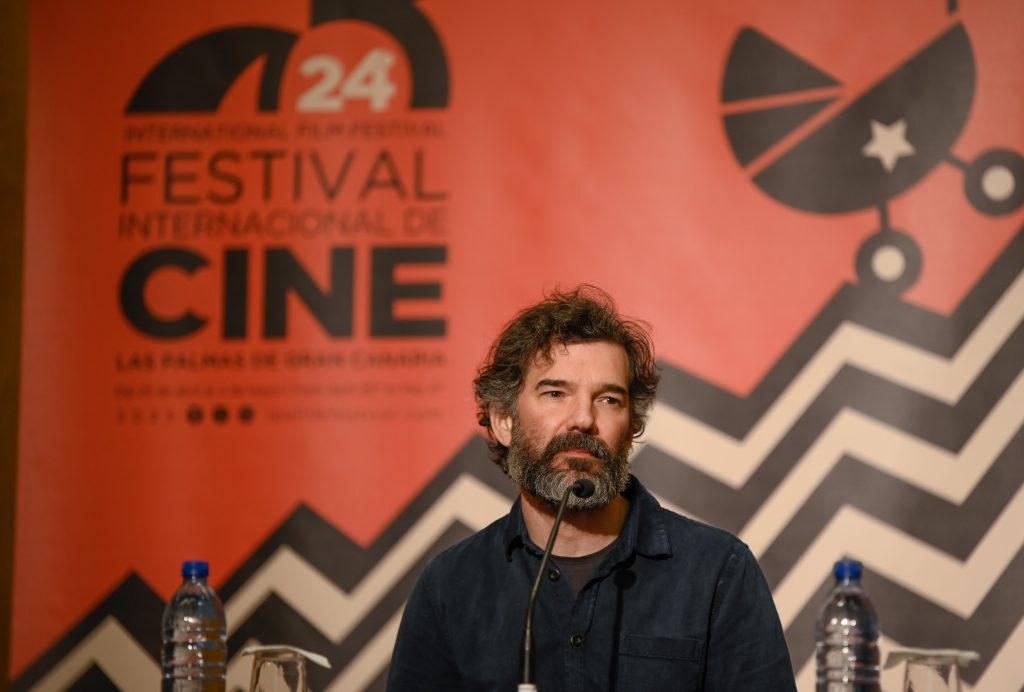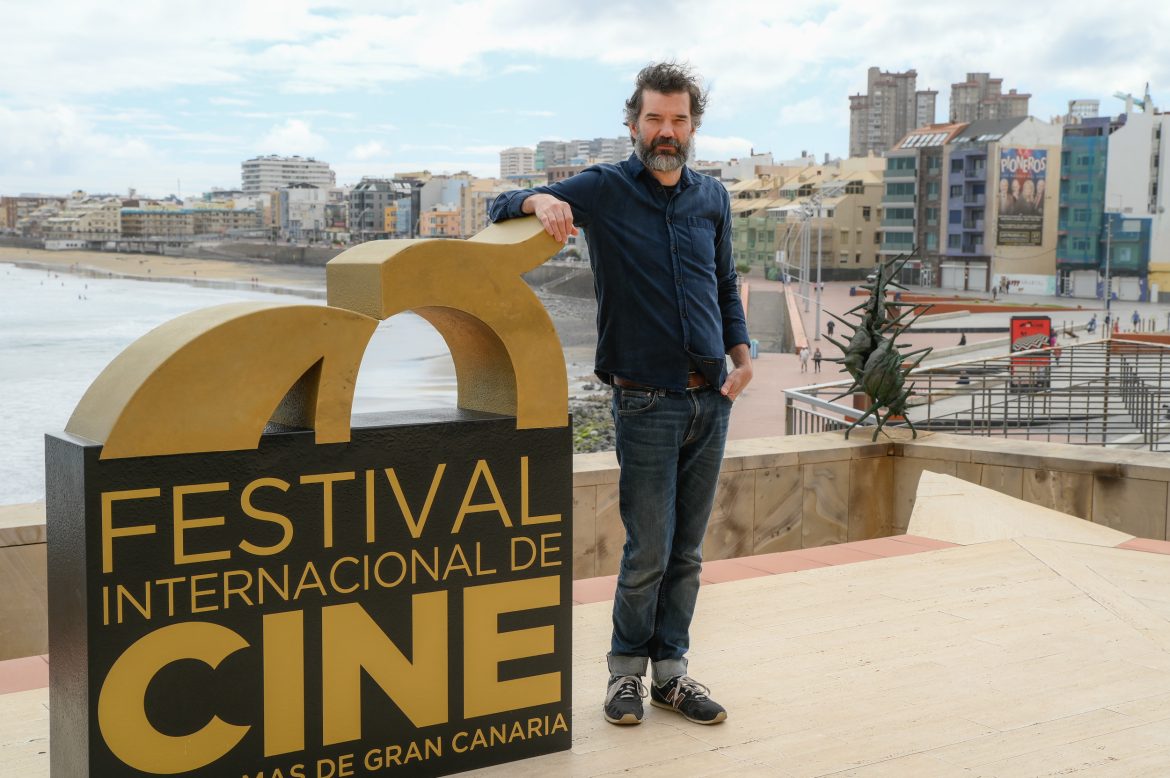• Its producer Ángel Santos has presented at the Festival “one of those films born from a filmmaker’s drive” that, after more than ten years of filming, turns the unique reality of a rural village family into fiction

04.29.2025. Alfredo Kraus Auditorium. Ángel Santos Touza. Las Palmas de Gran Canaria. Pictures: Eros Santana.
Las Palmas de Gran Canaria, Tuesday, April 29, 2025.- Iván Castiñeiras Gallego’s feature Deuses de pedra (Gods of Stone) is competing for the Golden Lady Harimaguada of the 2025 Las Palmas de Gran Canaria International Film Festival’s Official Section. A renowned cinematographer in films such as Bugarach (2014, Ventura Durall, Salvador Sunyer and Sergi Cameron), En todas as mans (2015, Diana Toucedo), Homes (2016, also by Toucedo) or Niños somos todos (2019, Sergi Cameron), he goes back now to filmmaking, always within the non-fiction genre. Indeed, ten years after the release of his last directed film, Where Is The Jungle, Castiñeiras returns to a directing role in a piece that delves into the reality of the Freitas family in the middle of rural and border villages between Galicia and Portugal.
The filmmaker could not speak to the media at the Alfredo Kraus Auditorium because his flight was affected by the power blackout the Iberian Peninsula experienced yesterday. However, the producer of the film, Ángel Santos, who is also the director of the last short film in which Castiñeiras worked as a cinematographer (Así vendrá la noche, 2021), did speak to them in a press conference. Santos claimed Deuses de pedra (Gods of Stone) was “an unusual production,” one of those films “that are born from a filmmaker’s drive,” rather than from an orchestrated project’s effort.
Santos himself is from an area of Galicia located on the border between the south of Ourense and Portugal. He told how Castiñeiras began to film “in the oldest border in Europe: there’s a very powerful imaginary there.” A sort of ethereal magic the director managed to capture “on his own, with little help and on 16mm, for over ten years.”
“Actually, we didn’t want to make a Galician-Portuguese Boyhood,” the producer noted when asked about Richard Linklater’s celebrated film that depicts its main character’s childhood and adolescence over a 12-year-long shooting process. Castiñeiras’ film also follows some of its characters, especially Mariana, during that same period of life.
However, Santos explained that Deuses de pedra was born from “both the landscape and the people. There was something much more collective there: a family that is important, and a vision even more kaleidoscopic from local people.” On the premise of such concept, the director “did focus on that growth.”
Pure filmmaking desire
From Santos’ own point of view as a filmmaker, Castiñeiras’ work is “pure filmmaking desire. You get to a point in which you don’t want to stop filming, and think you could keep on doing it endlessly.” Although he felt, at some points during the process, “a wish to turn to a more narrative approach, to be able to play a little bit more with fiction, but that really happened towards the end.”
In this story, the director would suggest to the protagonists, the local people, “small fictions they gladly accepted. There are some things in the film that are based on their lives, but then get fictionalized a bit and are approached in that playful way.” For instance, with Mariana, who experiences a dilemma in the feature that “perhaps wasn’t real.” Even though “her siblings have left, and his father is also in Azores. There’s clearly a family disintegration going on and she is finishing high school and thinking about that. In the film we decided to talk about it straightaway, rather than waiting to see what happened. But yes, she’s at that point of having to decide what to do.”
In any case, the work’s intention was always “observing those transformations, of something that is changing, something that is disappearing, something that is in the process of becoming something else.” That is, life in that Galician-Portuguese border. That’s why Santos noted that the final version of their film captures “the relationship we establish with rural life,” and, at the same time, the desire “not to let ourselves be carried away by stereotypes. The idea is to see this landscape not only as a place of memory, but also as a place that is still alive.” This way, we can see in the film “the area’s mining development, which is expanding a lot. Big European companies are arriving and that affects the neighbors. I think there’s a very honest look at this environment.”
The producer also revealed how the village inhabitants “remain an active part of the process. There’s a sort of very strong bond between them. We’ve scheduled a screening in their village for next summer, all of them are very involved and it’s going to be something pretty special.” Because Deuses de pedra has ended up becoming “a sort of collective celebration” in the area.
Producer and filmmaker
Ángel Santos talked to the media about his double role in the industry as a filmmaker and producer. And also about his willingness to support, within his limited possibilities, “those films that need to be release.” He pointed out that “my production company is very small and my producing ability is also modest, because I’m a filmmaker and I’ve always been kind of more in the other position, but there are certain things I can help with.”
“With Iván,” he added, “I was pretty clear from the beginning, and told him that I could get a small grant from Galicia’s Xunta to organize the shooting and finish the movie.” In addition, “we also submitted it to different film laboratories, to get small incentives.” In short, Santos rather played “a sort of accompanying role,” although he also meant something else for Castiñeiras, because “a filmmaker usually has that feeling, which I’m familiar with, of being alone with your project, and sometimes you need someone else to argue with, talk to or, above all, go through the editing phase together.”
Nonetheless, Santos highlighted that “there are works being made every year in Galician cinema, small steps being taken or even just some sort of evolution.” To the point that “what seemed to be intermittent or isolated cases have multiplied. A lot of movies are coming out in the next months, we are living fruitful times on a creative level.”
Partners, sponsors and collaborators of the 24th FICLPGC
The Las Palmas de Gran Canaria International Film Festival, organized by the Culture area of the Gran-Canarian capital’s City Council through Promoción de la Ciudad de Las Palmas de Gran Canaria, has received public assistance by the ICAA [Institute of Cinematography and Audiovisual Arts], the Visitors’ Program for the Internationalization of Spanish Culture (PICE), of the Spanish Public Agency for Cultural Action (AC/E), as well as public support from Promotur Turismo Islas Canarias.
Among the Festival’s collaborators we may find Fundación Auditorio Teatro, Cines Yelmo, Las Arenas Shopping Center and Hotel Cristina by Tigotan, places which also function as venues or hold activities of the film event; as well as other institutions and companies such as Sagulpa, Toyota, Royal Bliss, Fuze Tea, Coca Cola, Sholeo Lodge, Audiovisuales Canarias, Music Library &SFX, Blackout Films and International Bach Festival. Likewise, its market, MECAS, has been possible thanks to the sponsorship of the Gran Canaria Film Commission-Sociedad de Promoción Económica de Gran Canaria and the support of Proexca.
The University of Las Palmas de Gran Canaria, the Mid Atlantic University, Digital 104, the Audiovisual Cluster of the Canary Islands, the Association of Women Filmmakers and Audiovisual Media CIMA, the Cartagena International Film Festival, the Gijón International Film Festival, the Barcelona Independent Film Festival, the Tres Puertos Laboratory, Barcelona’s ESCAC, and Very Good Script, Freak World and Fimucité are also collaborators.
Share this Post

